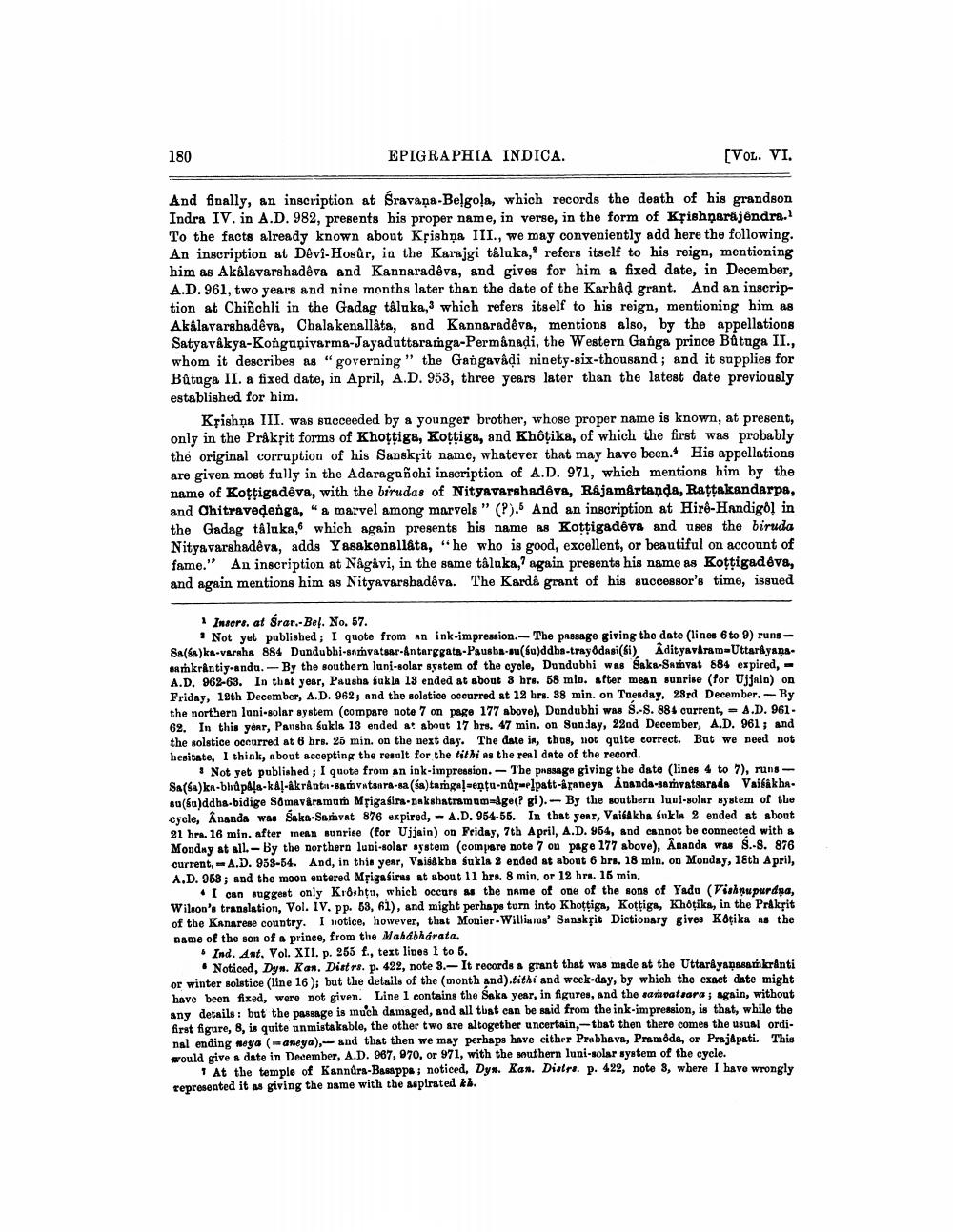________________
180
EPIGRAPHIA INDICA.
[VOL. VI.
And finally, an inscription at Sravana-Belgola, which records the death of his grandson Indra IV. in A.D. 982, presents his proper name, in verse, in the form of Krishnarajendra.1 To the facts already known about Krishna III., we may conveniently add here the following. An inscription at Dêvi-Hosûr, in the Karajgi taluka, refers itself to his reign, mentioning him as Akâlavarshadêva and Kannaradêva, and gives for him a fixed date, in December, A.D. 961, two years and nine months later than the date of the Karhâd grant. And an inscription at Chinchli in the Gadag tâluka, which refers itself to his reign, mentioning him as Akâlavarshadêva, Chala kenallata, and Kannaradêva, mentions also, by the appellations Satyavâkya-Kongupivarma-Jayaduttaramga-Permânadi, the Western Ganga prince Bâtuga II., whom it describes as "governing" the Gangavadi ninety-six-thousand; and it supplies for Bûtuga II. a fixed date, in April, A.D. 953, three years later than the latest date previously established for him.
Krishna III. was succeeded by a younger brother, whose proper name is known, at present, only in the Prakrit forms of Khoṭṭiga, Koṭṭiga, and Khôțika, of which the first was probably the original corruption of his Sanskrit name, whatever that may have been. His appellations are given most fully in the Adaragañchi inscription of A.D. 971, which mentions him by the name of Koṭṭigadêva, with the birudas of Nityavarshadêva, Rajamartanda, Raṭṭakandarpa, and Chitraveḍenga, "a marvel among marvels " (?). And an inscription at Hirê-Handigol in the Gadag tåluka, which again presents his name as Koṭṭigadeva and uses the biruda Nityavarshadêva, adds Yasakenallata, "he who is good, excellent, or beautiful on account of fame." An inscription at Nâgâvi, in the same tâluka,? again presents his name as Koṭṭigadeva, and again mentions him as Nityavarshadêva. The Kardâ grant of his successor's time, issued
1 Insors. at śrar.-Bel. No. 57.
Not yet published; I quote from an ink-impression. The passage giving the date (lines 6 to 9) runsSa(sa) ka-varsha 884 Dundubhi-samvatsar-Antarggata-Pausba-su(su)ddha-trayôdasi (si) Adityavaram=Uttarayanasamkrantiy-andu. By the southern luni-solar system of the cycle, Dundubhi was Saka-Samvat 884 expired,A.D. 962-63. In that year, Pausha fukla 13 ended at about 3 hrs. 58 min. after mean sunrise (for Ujjain) on Friday, 12th December, A.D. 962; and the solstice occurred at 12 hrs. 38 min. on Tuesday, 23rd December. By the northern luni-solar system (compare note 7 on page 177 above), Dandubhi was S.-S. 884 current, = A.D. 96162. In this year, Pansha Sukla 13 ended at about 17 hrs. 47 min. on Sunday, 22nd December, A.D. 961; and the solstice occurred at 6 hrs. 25 min. on the next day. The date in, thus, not quite correct. But we need not hesitate, I think, about accepting the result for the tithi as the real date of the record.
Not yet published; I quote from an ink-impression. The passage giving the date (lines 4 to 7), runsSa(sa)ka-bhapala-kal-akranta-samvatsara-sa (sa) tamgal-entu-nur-elpatt-âraneya Ananda-samvatsarada Vaisakhasu(su)ddha-bidige Somavaramum Mrigasira-nakshatramum-Age(? gi). By the southern luni-solar system of the cycle, Ananda was Saka-Samvat 876 expired, A.D. 954-55. In that year, Vaisakha sukla 2 ended at about 21 hrs. 16 min. after mean sunrise (for Ujjain) on Friday, 7th April, A.D. 954, and cannot be connected with a Monday at all. By the northern luni-solar system (compare note 7 on page 177 above), Ananda was S.-8. 876 current, A.D. 953-54. And, in this year, Vaisakha sukla 2 ended at about 6 hrs. 18 min. on Monday, 18th April, A.D. 953; and the moon entered Mrigasiras at about 11 hrs. 8 min, or 12 hrs. 15 min.
I can suggest only Krôshtu, which occurs as the name of one of the sons of Yadu (Vishnupurdna, Wilson's translation, Vol. IV. pp. 53, 61), and might perhaps turn into Khottiga, Kottiga, Khôtika, in the Prakrit of the Kanarese country. I notice, however, that Monier-Williams' Sanskrit Dictionary gives Kôtika as the name of the son of a prince, from the Mahabharata.
Ind. Ant. Vol. XII. p. 255 f., text lines 1 to 5.
Noticed, Dyn. Kan. Distrs. p. 422, note 3.- It records a grant that was made at the Uttarayanasamkranti or winter solstice (line 16); but the details of the (month and).tithi and week-day, by which the exact date might have been fixed, were not given. Line 1 contains the Saka year, in figures, and the samvatsara; again, without any details: but the passage is much damaged, and all that can be said from the ink-impression, is that, while the first figure, 8, is quite unmistakable, the other two are altogether uncertain,-that then there comes the usual ordinal ending meya (-aneya), and that then we may perhaps have either Prabhava, Pramoda, or Prajapati. This would give a date in December, A.D. 967, 970, or 971, with the southern luni-solar system of the cycle.
At the temple of Kannura-Basappa; noticed, Dyn. Kan. Distrs. p. 422, note 3, where I have wrongly represented it as giving the name with the aspirated ki.




